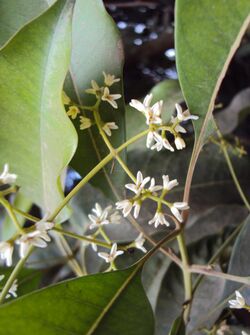Biology:Chionanthus ramiflorus
| Chionanthus ramiflorus | |
|---|---|

| |
| Flowers and leaves | |
| Scientific classification | |
| Kingdom: | Plantae |
| Clade: | Tracheophytes |
| Clade: | Angiosperms |
| Clade: | Eudicots |
| Clade: | Asterids |
| Order: | Lamiales |
| Family: | Oleaceae |
| Genus: | Chionanthus |
| Species: | C. ramiflorus
|
| Binomial name | |
| Chionanthus ramiflorus Roxb.
| |
| Synonyms[2] | |
|
Synonyms list
| |
Chionanthus ramiflorus, commonly known in Australia as northern olive or native olive, is a species of plants in the olive family Oleaceae. It is native to India , Nepal, northeastern Australia (Queensland), New Guinea, the Philippines , southern China and Taiwan.[3][4][1]
They grow as evergreen shrubs or trees to 3–23 m (10–75 ft) tall. The leaves are 8–20 cm (3–8 in) long and 4–7 cm (1.6–2.8 in) broad, simple ovate to oblong-elliptic, with a 2–5 cm (0.8–2.0 in) petiole. The flowers are white or yellow, produced in panicles 2.5–12 cm (1.0–4.7 in) long. The fruit is a blue-black drupe 1.5–3 cm (0.6–1.2 in) long and 0.5–2.2 cm (0.2–0.9 in) diameter.[3][5]
Sometimes the species is treated in the segregate genus Linociera, though this does not differ from Chionanthus in any character other than leaf persistence, not a taxonomically significant character.[6]
The 1889 book 'The Useful Native Plants of Australia' records that "The fruit of this plant is the food of the jagged-tailed bower-bird (Preonodura Neivtoniana). (Bailey.) This observation is interesting, and is the more valuable in that the vegetable foods of our indigenous fauna have very rarely been botanically determined. This plant is not endemic to Australia. Queensland."[7]
References
- ↑ 1.0 1.1 World Conservation Monitoring Centre (1998). "Linociera ramiflora". IUCN Red List of Threatened Species 1998: e.T33349A9778972. doi:10.2305/IUCN.UK.1998.RLTS.T33349A9778972.en. https://www.iucnredlist.org/species/33349/9778972. Retrieved 15 November 2021.
- ↑ "Chionanthus ramiflorus Roxb.". Royal Botanic Gardens, Kew. 2024. https://powo.science.kew.org/taxon/urn:lsid:ipni.org:names:608794-1.
- ↑ 3.0 3.1 Chang|Chiu|Wei|Green|2008}}|Chang et al. (2008) Flora of China. Online "Chionanthus ramiflorus". http://www.efloras.org/florataxon.aspx?flora_id=2&taxon_id=210000249.
- ↑ "Chionanthus ramiflorus Roxb.". Australian Plant Name Index (APNI), IBIS database. Centre for Plant Biodiversity Research, Australian Government. http://www.anbg.gov.au/cgi-bin/apni?taxon_id=10460.
- ↑ "Chionanthus ramiflorus". Centre for Australian National Biodiversity Research (CANBR), Australian Government. 2020. https://apps.lucidcentral.org/rainforest/text/entities/Chionanthus_ramiflorus.htm.
- ↑ Chang|Chiu|Wei|Green|2008}}|Chang et al. (2008) Flora of China. Online "Chionanthus". http://www.efloras.org/florataxon.aspx?flora_id=2&taxon_id=106706.
- ↑ J. H. Maiden (1889). The useful native plants of Australia: Including Tasmania. Turner and Henderson, Sydney. https://primo-slnsw.hosted.exlibrisgroup.com/primo-explore/fulldisplay?docid=SLNSW_ALMA21105097830002626&context=L&vid=SLNSW&search_scope=EEA&tab=default_tab&lang=en_US.
Cited works
- Chang, Mei-chen; Chiu, Lien-ching; Wei, Zhi; Green, Peter S. (2008). Wu, Z. Y.; Raven, P. H.. eds. Flora of China. 15 (Myrsinaceae through Loganiaceae). Beijing and St. Louis, MO: Science Press and Missouri Botanical Garden Press.
Wikidata ☰ Q5101416 entry
 |


